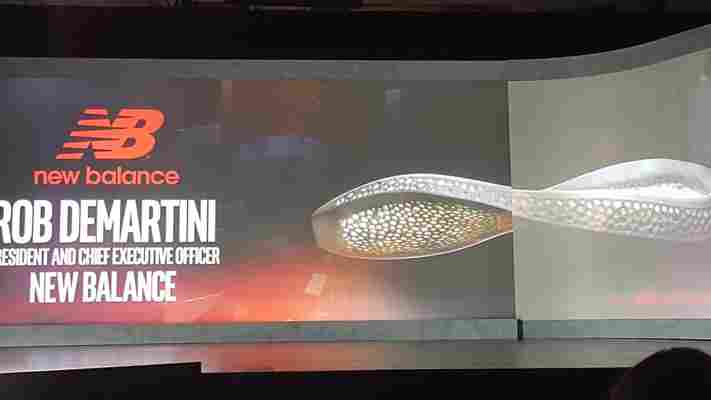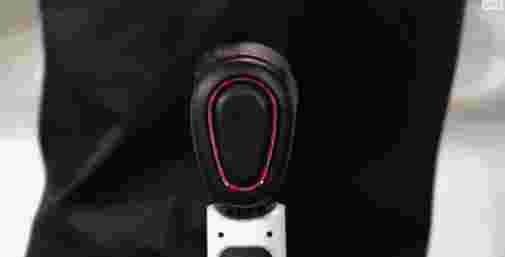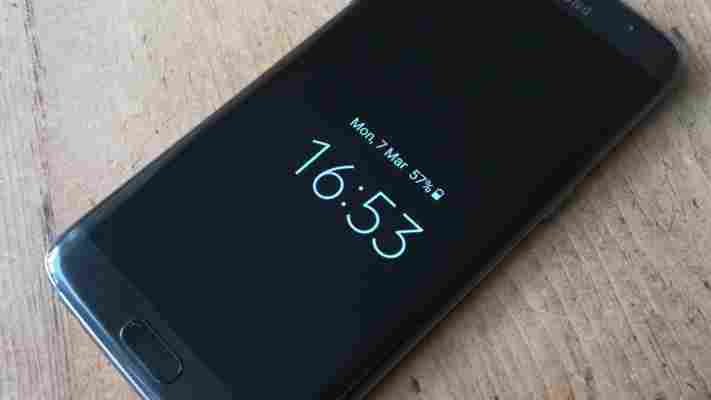New Balance wants to create customized 3D-printed midsoles for your sneakers
At the Intel CES press conference today, Intel and New Balance announced a partnership to use technology to personalize each customer’s foot to create a personalized midsoles for their running shoes.

To create the 3D model, New Balance will use Intel’s RealSense technology to measure each foot for the most accurate midsoles to support each customer. New Balance CEO Rob DeMartini said the new model of the sneakers will launch in April as a limited release in Boston. Soon, the company aims to install the technology for customers to get custom 3D-printed midsoles for their shoes right in the New Balance retail stores.
New Balance and Intel also announced plans to collaborate on a fitness smartwatch due for launch during the holiday season of 2016.
Unfortunately, neither Intel nor New Balance specified the price for the new running shoes. We’re expecting the personalized sneakers to start above $150 a pair, but we’ll update you as we learn more.
Watch this Intel-powered Segway transform into a robot butler
The Intel CES press conference has showcased many different integrations of its technology, but none have been more visually strange than a Segway that managed to transform into a self-navigating robot.

You could use it as a ‘hover’board of sorts, but with a touch of a button, the Ninebot Segway can turn into a robot, complete with blinking, camera eyes and movable arms.
You can speak to the robot and ask it to follow you – if that’s your thing – or have it go check your front door to welcome your guests. Obviously, its arms aren’t long enough to actually open the door, but you could use its camera eyes to check the door in your honor.
Segway says the robot will be commercially available in the second half of this year, as well as a developer kit. Let’s just hope it doesn’t blow up.
Samsung’s Galaxy S7 Edge: 9 things I love and 4 things I don’t
When the Samsung Galaxy S7 and S7 Edge were announced last month , I’d only had a short amount of time to get my hands-on the device, but having now spent three days using it as my daily driver, it’s time to take a look at the best and worst of the handset.

There’s a more detailed full review to check out too , of course, but these are my favorite – and least favorite – bits of the phone after three days.
Your favorites (or frustrations) may vary.ba
The phone is just as good looking as the first Edge – more so, in fact, as you can now get a black model Galaxy S smartphone again, which hasn’t been the case for a while. The additional curve added to the rear panel also helps the phone feel more comfortable in your hands.
Credit: Ben Woods/TNW
The Edge panels are useful for the first time . Yes previous models used them but they weren’t particularly useful – now you can quickly flick through a whole load of different information without having to jump through other menus. I still don’t use them all the time – you really need to get into the habit of actually realizing it’s useful – but I have at least used them this time out.
The always-on display is handier than I thought . While I could see the theoretical benefit of the always-on display, I doubted how much use it would really be. I was wrong. Sure, virtually every screen around me has a clock on it and I wear an S2 Classic most days, but it still came in handy. Make of that what you will.
Credit: Ben Woods/TNW
The camera is much improved . Lots of phones can take respectable, if not glorious photos in bright sunlight, but most smartphones suffer in more dull or outright dark conditions. From early testing with the S7 Edge, this shouldn’t be too much of a problem. I also like the live effects preview and quick controls for adjusting the strength of the effect before you even take a shot.
Credit: Ben Woods/TNW
MicroSD cards return! This might seem like a small one, but I don’t necessarily want to spend an inordinate amount of time deleting photos or apps simply to be able to continue to use my phone. And nor do I want to store my entire life in the cloud necessarily.
Samsung now supports moving apps to a microSD card to free up space, in addition to photos, although it does it in a non-standard way.
Quick charge lets you go from zero to max in less than two hours – but only when using the included cable/charger.
Waterproofing brings peace of mind. For me, the idea of going swimming with my phone isn’t one that really appeals – and nor should it if you’re planning on buying an S7 or S7 Edge, both are IP68 rated, but they’re not designed for prolonged use at any sort of depth. What it does mean, however, is that you don’t need to worry if drop it in the sink when you’re doing the dishes, or you can take it in the shower if you just can’t pull yourself away from the latest episode of Serial.
Credit: Ben Woods/TNW
The fingerprint sensor actually works. Don’t underestimate how frustrating a sometimes-functioning fingerprint sensor can be. Needing to attempt it four or five times sort of renders the convenience of it useless. Luckily, this isn’t the case for the S7 Edge and I find it more reliable buried in the home button where it is, rather than on the back such as on a Huawei or HTC, or on the side like on the Nextbit Robin .
Credit: Ben Woods/TNW
It doesn’t use USB Type C. This might feel counter-intuitive, but I’m pretty happy that the S7 doesn’t use the new standard connector, because in reality it hasn’t yet established itself as the standard . What this means is that when you forget your cable, you’re screwed. No one will have one in your office, most likely. The situation will be better when Type C is more commonplace, but for now there’s not a lot of difference between proprietary and standardized.
Credit: Ben Woods/TNW
It’s beautiful – and sort of slippery to hold. The front is curved, the screen goes all the way round and the back also now has an additional curve. It makes it more comfortable, but no less drop prone. In reality, if you’re handing over your cold, hard cash for this phone you’ll probably want to put it in a case to protect it, which sort of ruins that beautiful design.
The battery life was oddly short on my first day . The 3,600mAh pack powers a beefy phone and does a fine job, but on the first day it really felt like it was coming up short. Admittedly, I was setting the phone up, downloading apps, updating everything etc. – so it was a highly demanding day for the battery. Since then, it’s seemed a little better on battery life. By around 6PM, I’m down to around 50 percent with average use – not light use, but no video streaming either.
You probably won’t get a full two days out of it if you’re a demanding user but that might not be a problem for you – and the quick charging really helps in this regard. The battery definitely didn’t make the same impression of longevity that the Mate 8’s did though. I’ll continue to keep an eye on this one.
There might be a few software issues still waiting to be worked out. While performance has been zippy and almost faultless so far, the ‘almost’ part of that sentence refers to one occassion where it froze for 30 seconds to a minute, and then just rebooted with no warning. Often, software updates roll out to fix this sort of niggling issue, but it defintely stopped and made me go, ‘Hmm’.
The screen is still a fingerprint magnet , but perhaps that’s just the price of beauty.
There are lots of reasons to like the Samsung Galaxy S7 and a decreasing number to dislike the family of handsets – if Samsung can take this sort of approach to the rest of its devices, it should continue to see commercial success. However, whether these small problems will be quickly ironed out, or whether they’ll grow to be real annoyances still remains to be seen.
Read next: Samsung Galaxy S7 Edge review: Beauty and killer performance make this phone the real deal
